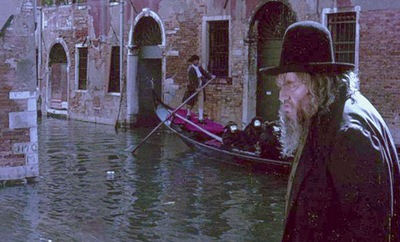
(Editor’s note: Seth Alexander Thévoz was kind enough to offer us to provide us with details on the restoration of “The Merchant of Venice,” which will be shown on Sept. 1 at the Venice Film Festival).
By SETH ALEXANDER THÉVOZ
This evening I saw Stefan Droessler for the first time, when he presented one of his Welles clip compilations at the BFI in London. I managed to catch him for a few minutes afterwards in the foyer, and asked him about the forthcoming Merchant of Venice reconstruction, which he confirmed he’s supervising; he says editing is ongoing, and they’ll only just finish it in time before the 1st September premiere in Venice.
Before anyone shoots me down on the details, I’m just setting down what he told me – some of it was entirely at odds with what I’d previously understood about the project!
Firstly, he said that the film was always meant to be four reels long (not three, as I’d previously understood). The current nine-minute reel that’s been doing the rounds (and which was screened tonight) is the second reel of the film, which explains its abrupt beginning.
The first reel has been found, intact, with sound.
The third reel has been found, but has no sound.
Droessler insisted that the fourth reel was never filmed – something Oja confirmed to him, apparently. To elaborate, Welles’s pared-down version of The Merchant of Venice focuses entirely on the story of Shylock, missing the trial scene altogether, and concluding with Shylock giving his “hath not a Jew eyes?” speech. When the first and third workprint reels went missing, Welles had not filmed the fourth reel, and still intended to do so.
For the missing sound on the third reel, Droessler said that he had a problem; he didn’t want to put it together with subtitles, because he said that the whole point of a Shakespeare film is in the quality of the spoken word, and so ten minutes of silence wouldn’t work. Nor, he said, would Oja Kodar permit “somebody else to dub Orson’s voice”. Accordingly, what he’s done (and he interjected “and I know some Wellesian purists are going to hate this!”) is synched the film to Welles’s 1939 gramophone recording of The Merchant of Venice. “With digital trickery you can do this, and it works very well”. He conceded that the voices still noticably differ in the 1939 recording from the 1969 film – Welles’s own voice in the earlier recording is deeper, as he worked harder to sound like an old man, and he didn’t adopt the same accent as in 1969 – but Droessler says that with all the dialogue being taken from Shakespeare, and with the same lines being used in both the 1939 recording and the 1969 film, that apparently it works quite well.
For the missing fourth reel, he decided against using one of the takes of Welles doing the “Hath not a Jew eyes?” speech in France and Spain in the 70s in a trenchcoat, saying that it would have been disconcerting to jump from the heavy atmosphere of the Venetian period piece to a modern-setting speech with road and air traffic clearly audible in the background.
(And having seen those 1970s takes tonight, I’m inclined to agree with him on that point. Incidentally, he confirmed that he has half an hour of 1971 takes shot against the French sunset during the making of La Décade prodigieuse, and a quarter of an hour of 1973 takes shot at dawn in Spain when scouting for TOSOTW locations, including at least one full take of the speech in each setting. But for those who haven’t seen the reels, I should confirm that most of the material is made up of flubbed takes, usually with background traffic or someone walking past in shot.)
Instead, for the fourth reel, he’s going to keep running the 1939 recording of Welles going into his “Hath not a Jew eyes?” speech over a still-frame of Welles in his 1969 Shylock make-up, since Droessler says “I felt it would be too confusing to come in with a *third* Orson Welles voice for Shylock in the same half-hour.”
He also confirmed that he now has a complete screenplay for the first time: “Until I had that, I had no idea how Welles was going to fuse together those first three reels with closing on the Shylock speech, but now I understand.”
For the soundtrack, Droessler confirmed that he has a complete recording of the one and only performance of the score by Lavagnino which is being used for the reconstruction, and that Lavagnino made notes around the time of the performance, on how the music should be integrated with the film; notes which Droessler has used. Lavagnino’s notes confirm that at the time of the recording, Welles still had not shot the fourth reel, but that he had some ideas around that, and had discussed them with Lavagnino.
The final running time of the Droessler restoration is projected to be 36 minutes. He said the quality of the picture would be “much, much better than what you see in the [workprint] reel tonight”, which suggested to me (though he didn’t directly say so) that they’d be cutting the restoration from the surviving negative material, since the discovery of the workprint reels means they now know what pattern to cut to.
That was a huge amount of new information! Droessler rattled through the whole situation in 5-10 minutes, and I’ve jotted this down on the train straight after listening to him!
________
Post your comments on the Wellesnet Message Board.
